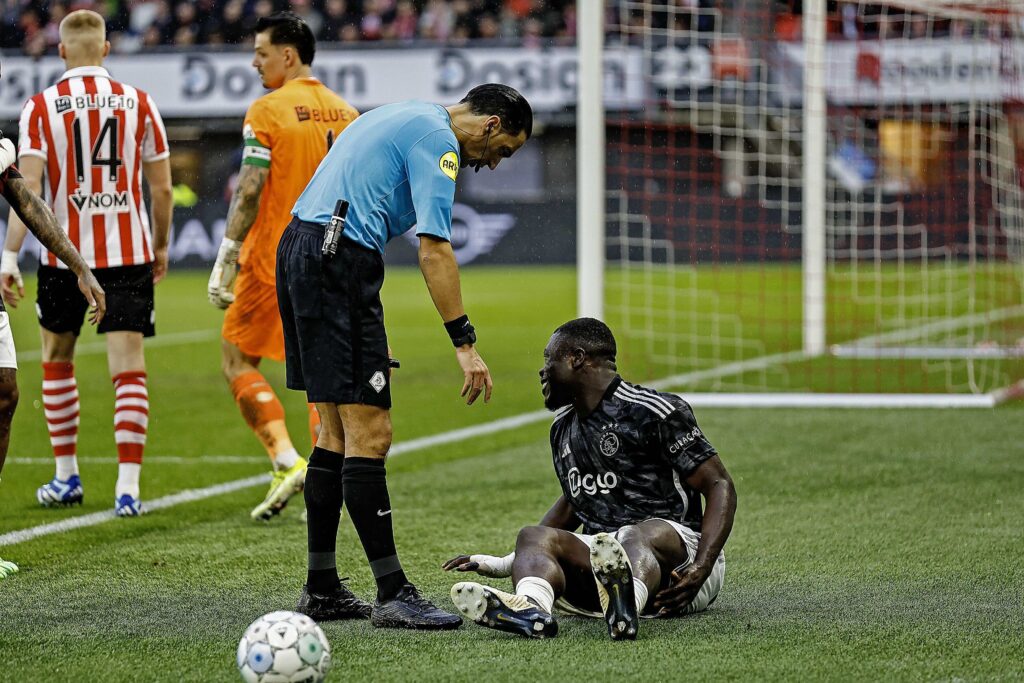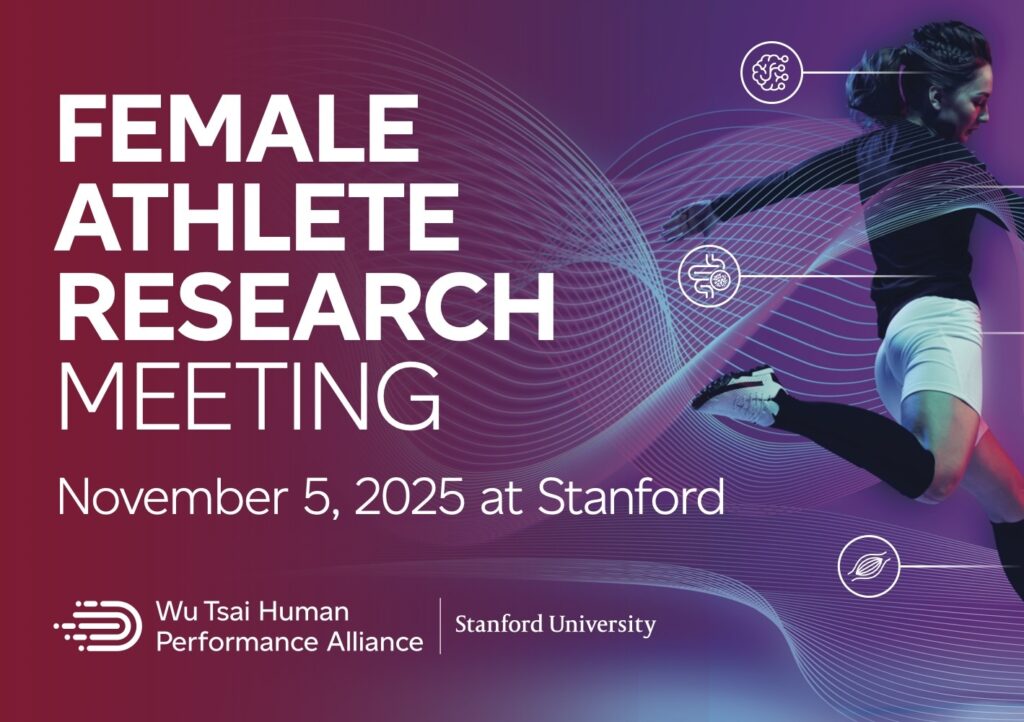Innovative techniques shed light on hamstring injury prevention in athletes
Collaborators

Two new studies provide insights into hamstring injuries and prevention under real-world conditions like never before, enhancing our understanding of how muscles adapt to training and why such injuries are so common.
By: Kristy Hamilton
Hamstring injuries are plaguing athletes across the globe, accounting for 10% of all injuries in field-based sports. Despite their frequency, the mechanisms behind these injuries and effective prevention strategies remain unclear. Findings from two recent studies offer new insights on hamstring injury prevention.

Ajax player Brian Brobbey experienced a hamstring injury and had to withdraw from the game. Image credit: Pro Shots / Alamy Stock Photo
In the first of two studies, researchers from The University of Queensland and Stanford University, in collaboration with Stanford Athletics, explored the effects of nine weeks of Nordic hamstring exercises – a popular training method aimed at preventing hamstring strains – on the muscle structure of 12 participants. Utilizing a novel microendoscopy technique developed at Stanford, the team measured the effects of training on human hamstrings at an unprecedented level of detail. The study is published in the Journal of Sport and Health Science.
“The truly unique part of this study was our ability to examine the microscopic adaptations of the muscle in response to Nordic hamstring exercises. No other studies have been able to explore this in humans,” said Scott Delp, the James H. Clark Professor of Bioengineering at Stanford University and senior author of the study, as well as Director of the Wu Tsai Human Performance Alliance at Stanford.
Delp and Mark Schnitzer, the Anne T. and Robert M. Bass Professor in Stanford’s School of Humanities and Sciences, previously developed a microscope capable of visualizing sarcomeres — the fundamental units within muscle fibers responsible for generating muscle force — in humans.
Using the microendoscope, the researchers observed significant changes in the biceps femoris long head muscle, one of the four muscles that comprise the hamstring, following the 9 weeks of Nordic hamstring exercises. Notably, sarcomeres were getting added end-to-end to existing sarcomeres. This growth pattern lengthens the muscle fibers and could decrease the amount of stretch each sarcomere experiences, protecting muscle fibers from overstretching.
Some muscle areas experienced sarcomere increases up to 49%. However, both muscle fiber lengthening and sarcomere increase began to decline after a three-week break from training.
“Our findings, along with previous work from our group, highlight the importance of long-term training to induce meaningful adaptations in the hamstrings,” said Max Andrews, first author and a graduate student at the University of Queensland. “While Nordic hamstring exercises are often used by coaches in short blocks, such as 3-4 weeks during pre-season, this may not be enough to induce the necessary adaptations we observed. And consistent training is essential to maintain these muscle changes.”
Exploring Hamstring Behavior During Accelerations
Another strategy for preventing hamstring injuries involves monitoring exposure to high-speed running. While hamstring injuries have been linked to running at high speeds, a second study from Delp’s team, published in Medicine and Science in Sports and Exercise, reveals that speed alone doesn’t tell the whole story.
The researchers found that hamstrings stretch to greater lengths and at faster speeds during acceleration from lower running speeds compared to maintaining a constant top speed. This may explain why hamstring strain injuries often occur during acceleration.
“Running speed alone is insufficient to fully characterize hamstring biomechanics,” said first author Reed Gurchiek, who conducted the study as a postdoctoral fellow with the Wu Tsai Human Performance Alliance at Stanford and is now an assistant professor at Clemson University. “Our data showed that hamstrings are stretched similarly when accelerating from 50% of top speed as when running at a constant 88% of top speed.”
To visualize this, think of your hamstring muscles as a rubber band. When running at a steady pace, the rubber band stretches as the leg moves. However, during sudden acceleration, the rubber band is stretched more intensely and quickly.
The team used the smartphone-based OpenCap system to capture motion data for their experiment outdoors on a natural running surface, providing more realistic movement data compared to previous treadmill-based studies.
The low-cost, smartphone-based OpenCap technology can capture and analyze motion data for experiments on a natural running surface. Image credit: Scott Uhlrich / Stanford Neuromuscular Biomechanics Lab.
“During games and practices, athletes often accelerate from a moving start (e.g., jogging) and rarely from a still position like at the start of a 100m sprint,” explained Gurchiek. “We wanted to emulate this type of accelerative running in our study. OpenCap made it possible.”
The team discovered a lot of variability in how participants accelerated. Some demonstrated techniques that minimized hamstring injury risk, while others struggled to control their pelvis and torso, leading to rapid hamstring stretching. As a result, certain individuals are at a much greater risk of hamstring injury during acceleration.
These findings can improve athlete monitoring to prevent hamstring injuries, Delp said. “The vision is to screen athletes with OpenCap, plot them on a standardized curve, and see who’s at risk and who’s not,” he added. “This could be a valuable tool across various sports where hamstring injuries are common.”
Schnitzer is also a Professor of Applied Physics and of Neurosurgery at Stanford.
The first study was supported by the Australian Research Council Discovery Project (DP200101476), and in part by National Institute of Health grants (R01 AR077604, RO1 EB002524, RO1 AR079431, and P41 EB027060), Stanford Graduate Fellowship, The University of Queensland Graduate Scholarship, National Health and Medical Research Council of Australia Fellowship (#1194937), and by Wu Tsai Human Performance Alliance at Stanford University and the Joe and Clara Tsai Foundation.
The second study was supported by the Wu Tsai Human Performance Alliance at Stanford University and the Joe and Clara Tsai Foundation, and the National Institutes of Health (Grant P41EB027060)
Media Contacts
Kristy Hamilton
Science Writer and Communications Specialist
[email protected]
Joy Ku
Senior Director of the Wu Tsai Human Performance Alliance at Stanford
[email protected]
Latest News

July 21, 2025
Save the date: Female Athlete Research Meeting

July 21, 2025
Alliance Round-Up: Probiotics at high altitude, sleep timing and physical activity, and more

May 29, 2025
Is exercise before sleep linked with poorer sleep?
Get Engaged
Join our mailing list to receive the latest information and updates on the Wu Tsai Human Performance Alliance.
